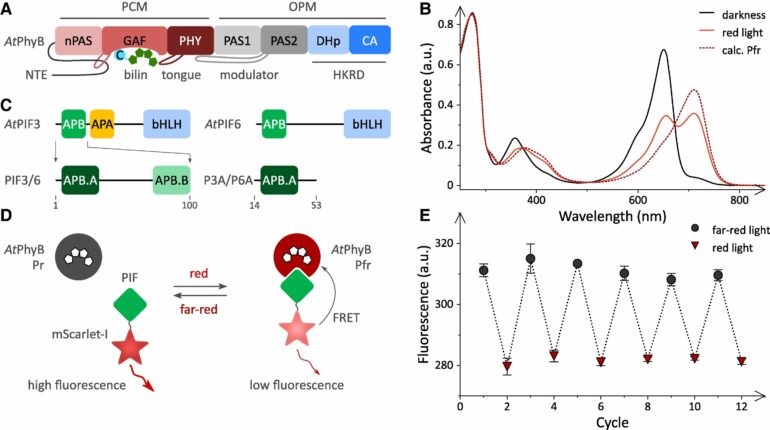Researchers at the University of Bayreuth and Heinrich Heine University Düsseldorf have described a previously unknown mechanism in the perception of light and heat in plants. The results contribute to a better understanding of plant physiological processes. The findings are published in the journal The Plant Cell.
Plants can perceive light and heat via so-called phytochromes and use these pigments to trigger vital reactions such as growth. Climate change and steadily rising temperatures can disrupt plant metabolism, which slows down growth and can lead to the death of plants—including crops.
Against this background, an understanding of the molecular basis of the mechanisms that control light and heat perception in plants is essential. The results can also lead to progress in the control of cellular activity by light (optogenetics), in biotechnology and in basic research.
Plants must constantly adapt to different environmental conditions, such as different temperature and light conditions throughout the day. These stimuli are perceived at the molecular level via phytochromes, which change their states when the temperature or wavelength changes. They interact with other proteins such as phytochrome-interacting factors (PIFs), which trigger physiological responses to the stimuli, such as growth.
Phytochromes react to red light: in the dark, phytochromes are in the inactive Pr state; when irradiated with red light, they are converted to the active Pfr state. This change of state can be reversed by changing temperature or irradiation with far-red light between 710 and 740 nm wavelength. This reaction illustrates the dual function of phytochromes in the perception of heat and light, i.e., as thermoreceptors and photoreceptors.
A central component of the thermoreception of phytochrome B of thale cress (Arabidopsis thaliana) is the pronounced temperature dependence of the transition from the Pfr state to the Pr state. This conversion accelerates more than tenfold at temperatures between 4°C and 27°C. However, the extent to which the interaction between phytochrome B and different PIFs can contribute to the thermoreception of plants was previously unknown.
This is where Prof. Dr. Andreas Möglich and doctoral student Chengwei Yi from the Photobiochemistry working group at the University of Bayreuth came in. Together with researchers from Heinrich Heine University Düsseldorf, they investigated the speed of formation and dissolution of complexes of phytochrome B and various PIFs under red and far-red light and at different temperatures. The dissolution of the complexes accelerated many times over between 15°C and 30°C, whereas this did not apply to complex formation.
When investigating the interaction between phytochrome and PIF under red light, the researchers came across an unexpected effect: under strong continuous light, the extent of complex formation decreased with the intensity of the red light instead of increasing as expected. The reason for this is a rapid, red light-driven and bidirectional conversion between the Pr and Pfr states.
“Plant phytochromes can therefore convert different red light intensities and temperatures into physiological reactions via an additional, previously unknown and therefore unexplored molecular mechanism,” says Chengwei Yi, first author of the study.
The results enable advances in the use of plant phytochromes in biotechnology, for example, for the precise control of gene activation for the production of proteins. They also have an impact on the perception and integration of light and temperature signals in plants.
More information:
Chengwei Yi et al, Plant Phytochrome Interactions Decode Light and Temperature Signals, The Plant Cell (2024). DOI: 10.1093/plcell/koae249
Provided by
Bayreuth University
Citation:
Researchers uncover new plant perception mechanism for light and heat (2024, October 7)



